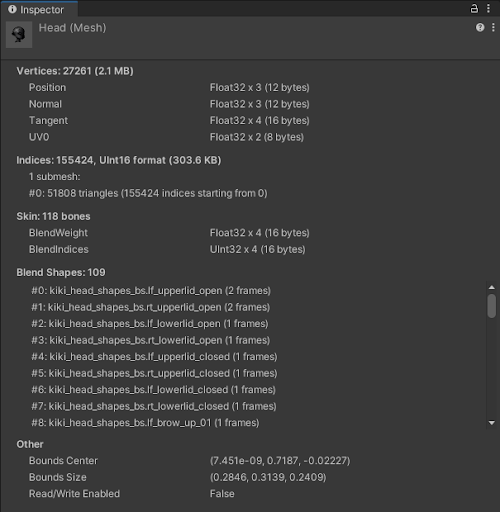Mesh asset Inspector window reference
Switch to ScriptingA MeshThe main graphics primitive of Unity. Meshes make up a large part of your 3D worlds. Unity supports triangulated or Quadrangulated polygon meshes. Nurbs, Nurms, Subdiv surfaces must be converted to polygons. More info
See in Glossary asset represents a mesh in your Unity project.
Unity creates mesh assets by default when it imports modelsA 3D model representation of an object, such as a character, a building, or a piece of furniture. More info
See in Glossary. You can also create mesh assets directly in Unity, for example, by creating a mesh with code and saving the results as an asset.
Select a mesh asset in the Project windowA window that shows the contents of your Assets folder (Project tab) More info
See in Glossary to open the Mesh InspectorA Unity window that displays information about the currently selected GameObject, asset or project settings, allowing you to inspect and edit the values. More info
See in Glossary. This Inspector displays information about the mesh, such as the total number of vertices or the names of any blend shapes the mesh has. It also displays a visual preview of the mesh.
Mesh information
The Mesh Inspector displays information about how the mesh asset storesA growing library of free and commercial assets created by Unity and members of the community. Offers a wide variety of assets, from textures, models and animations to whole project examples, tutorials and Editor extensions. More info
See in Glossary its data, but not the values in the data itself. For example, the Inspector shows that Unity stores the value for Position as a set of three Float32 values for each vertex, but it doesn’t show the Position value of a specific vertex.

| Property | Description |
|---|---|
| Vertices | The total number of vertices in the mesh, and how much on-disk storage and runtime memory Unity uses to store the vertex data for the mesh. For each vertex attribute, Unity shows how much on-disk storage and runtime memory Unity uses to store that attribute, and the data type that Unity uses for it. For more information about this data, see Mesh data. For information about how Unity can compress data in a mesh, see the Compressing mesh data. |
| Indices | The total number of indices in the mesh, how much on-disk storage and runtime memory Unity uses to store this data, and information about the indices for each sub-mesh. For more information about this data, see Mesh data. |
| Skin | This section is only visible on a skinned mesh. The options are:
|
| Other | Shows additional information. The options are:
|
Mesh preview
This part of the Inspector allows you to preview the appearance of a mesh and explore the mesh data in a visual way.
You can use the following properties in the UI to configure the view:
| Property | Description |
|---|---|
| View mode | Provides different ways of visualizing the mesh. For more information, refer to View mode dropdown. |
| Wireframe | Not available in UV Layout mode. If enabled, the preview displays a visualisation of the vertices and edges. Otherwise, it doesn’t. |
| Channel picker | Only available in UV Checker mode. This drop-down menu allows you to change which UV channel the preview displays. If the mesh only uses one UV channel, then only “Channel 0” is enabled. |
| Texture size | Only available in UV Checker mode. This slider allows you to change the size of the checkered texture on the mesh’s UV layout. |
| Blend shape picker | Only available in Blendshapes mode. This drop-down allows you to change the blend shape that Unity visualizes in the mesh preview. When you select a different blend shape, Unity no longer applies the previous blend shape to the mesh preview. |
View mode dropdown
For more information, refer to Use the Mesh asset Inspector Preview.
| Value | Description |
|---|---|
| Shaded | Provides a visualization of the mesh with a basic light. This is the default view. For more information, see Shaded view. |
| UV Checker | Applies a checkerboard texture to the mesh to visualize how the mesh’s UV layout maps textures. For more information, see UV Checker view |
| UV Layout | Displays how the vertices of the mesh are organized in the unwrapped UV layout. This view disables the Wireframe toggle. For more information, see UV Layout view |
| Vertex Color | Visualizes any vertex colors that the vertices in this mesh have. If no vertices have a vertex color, this menu item is disabled. For more information, see Vertex Color view |
| Normals | Visualizes the relative directions of the normals in the mesh with color. For more information, see Normals view |
| Tangents | Visualizes the tangent data in the mesh with color. For more information, see Tangents view |
| Blendshapes | Lets you preview blend shape deformations to the mesh. If the mesh has no blend shapes, this menu item is disabled. For more information, see Blendshapes view |